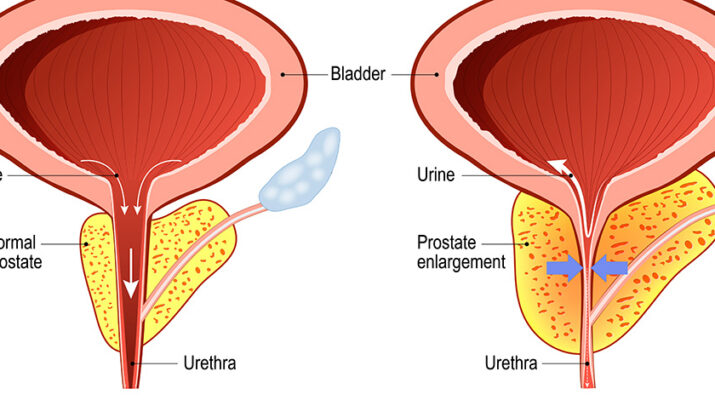Enlarged prostate gland is a very common problem, and affects most men over 50
By Barbara Pierce

Upstate Urology in Utica, Mohawk Valley Health System.
An enlarged prostate gland is a normal part of aging for most men, explained physician Hanan Goldberg, Upstate Urology in Utica, Mohawk Valley Health System.
“Known as BPH [benign prostatic hyperplasia], an enlarged prostate gland causes urgency in the need to urinate, increased frequency in the need to urinate, leakage, a weak stream, infection, even kidney disease,” he said.
An enlarged prostate may also cause urethral stricture, obstructing the bladder from emptying completely.
“An enlarged prostate gland is a very common problem,” Goldberg said. “For men between the ages of 51 to 60, one out of two have an enlarged prostate. Up to 90% of men over age 80 have an enlarged prostate. The prostrate continues to grow with age. We’re living longer so prostrate problems are becoming more common. They do cause a lot of issues for men.”
BPH is benign. It is not cancer, nor does it lead to cancer.
Until recently, treatment options were medication or surgery. Many of these options produced unwanted side effects. Medication can help treat BPH. However, the medications often fail after using them several years. Failure, in the sense that symptoms continue to progress despite using medications.
Now, thanks to Goldberg and MVHS, there’s a new option for men seeking a rapid, minimally invasive, long-lasting solution to an enlarged prostate with few side effects. It’s called aquablation.
Aquablation uses a tiny, high-pressure jet of water to remove excess tissue.
The procedure was approved by the FDA a few years ago.
MVHS is the first in Upstate New York to offer this treatment. “We’re the only ones outside of New York City to offer this,” Goldberg added. “We have patients coming from all over the state to take advantage of it. They hear about it and come in for the procedure.”
The procedure, done on an out-patient basis, takes from 30 minutes to two hours. The patient is asleep during the procedure and doesn’t feel or remember anything, said Goldberg. The patient leaves the same day, with a catheter that is removed two to three days later when he returns for a follow-up visit.
There is very little discomfort after the procedure and essentially none within a few days.
“There are two novelties about this,” explained Goldberg. “First, it uses a high-pressure water jet instead of a laser. That means less heat, fewer side effects. The other novelty is that a robotic arm does the procedure. An ultrasound probe and a camera are both inserted to view the prostrate. With these two methods, we have the ability to view the entire prostate. The robotic arm maps the area to be removed. This cuts the time of the surgery significantly. What we surgeons do is clean out the area and stop any bleeding. Most of the work is done by the robotic arm.”
The work is a heat-free, high-pressure water jet that comes from a robotic probe that goes inside through the prostate. The water actually completely ablates, or removes the tissue; it actually makes the tissue disappear completely. It disappears completely because the water jet is so strong.
“This is a minimally invasive procedure,” Goldberg said. “There are no incisions. We don’t open the abdomen. We go in through the urethra, a natural orifice and use a water jet controlled by robotic technology to remove prostate tissue and open the channel so that men can empty their bladder.”
For most men, this will be the first and final procedure they will need. The prostate tissue does grow back, but does take a long time to grow back. Most men will not need any additional procedures after this. Aquablation does remove a significant amount of tissue. With the amount of tissue that is removed, the time it will take the tissue to grow back is many years.
“We don’t do this surgery for everyone,” added Goldberg. “For example, for men with a small prostate gland, there are better options.”
Aquablation is a remarkably effective procedure, according to Goldberg. It’s a long-lasting treatment option for men with BPH and has the lowest risk of sexual and other side effects compared with traditional prostate surgeries.
“It’s the gold-standard procedure for an enlarged prostate,” Goldberg said.
The aquablation procedure is covered by Medicare and most insurances.

